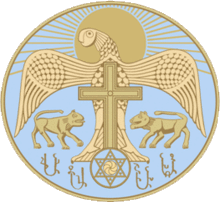Principality of Chatschen


The principality of Chatschen ( Armenian Խաչենի իշխանություն Chatscheni ischanutjun , Greek Χατζιένη or Χατσέν ) was a medieval Armenian principality in Nagorno-Karabakh on the territory of the historic Armenian province of Arzach (today's Republic of Arzach ), which existed from 821 to 1750. From the 12th to the 15th century, the Armenian principality of Khatschen ruled what is now known as Nagorno-Karabakh.
Chatschen was founded in 821 and initially ruled by Armenian princes from the Siunia ( Sjunik ) family. According to Abū Dulaf, an Arab traveler, Chatschen was an Armenian principality immediately south of Barda'a . The Eastern Roman Emperor Constantine VII addressed his letters to the Prince of Chatschen with "To the Prince of Chatschen, Armenia" ( Greek εἰς τὸν ἄρχοντα τοῦ Χατζιένης, Ἀρμενία ).
In 1116 the Kingdom of Sjunik was united with Chatschen by marriage. In 1170, Greater Armenia was conquered by the Seljuks , so that Khatschen under Hassan I remained one of the last still independent Armenian principalities. In the first half of the 13th century Khatschen became dependent on the Armenian rulers Zakarian, but it was already subjugated by the Mongols in the 1230s.
With Hassan II Jalal-Daula (approx. 1214-1265), king of Arzach and Baghk ( Sjunik ), a new branch of the Armenian family of Siunia, the house of Hassan-Jalaljan , took over the prince throne of Chatschen. From 1214 the dynasty Hassan-Jalaljan ruled large parts of today's Nagorno Karabakh (Chatschen, Arzach). In 1216, the princes Hassan-Jalaljan founded the Gandsassar monastery , where the Catholicos of Aghwank (Albania) took his seat after he had to leave Barda'a (Partav) in the course of Islamization .
As a result of the incursions and devastation by Timur at the end of the 14th century, the power of the Khatschen principality collapsed. In the period that followed, under the domination of the Turkmen Qara Qoyunlu in the Nagorno-Karabakh region, five Armenian principalities emerged, of which Khachhen was only one. These Armenian princes now bore the title Melik ( Arabic ملك"King"). The five Armenian principalities of Karabakh , also Chams or Chamsa ( Arabic خمسة"Five"), were given their independence until the wars between the Ottoman Empire and Persia under the Safavids . In 1603 the Persians under Shah Abbas I established a protectorate over Chamsa. In 1726 and 1727, the nobility and peasants in Chatschen and the other Armenian principalities jointly resisted the invading Ottoman troops. The Russian Prince Dolgoruki reported with astonishment how the small Armenian armed forces withstood a superior force of 40,000 Turkish soldiers. An alliance with the later Persian ruler Nadir Shah ultimately led to the victory over the Turks and to an autonomy of the Machale Chamsse ("united land of the five melics") under Persian rule. Eventually, however, the Khan Panah-Ali (1693–1761) succeeded in subjugating the Chamsa, and in 1750 the five Armenian principalities were incorporated into the Karabakh Khanate .
Individual evidence
- ↑ Christine Angelidi: ΕΥΨΥΧΙΑ. Mélanges offerts à Hélène Ahrweiler. Publications de la Sorbonne, Paris 2016. Χατζιένη (Χατσέν) .
- ^ Encyclopædia Britannica: Armenia.
- ^ Charles JF Dowsett : The Albanian Chronicle of Mxit'ar Goš. BSOAS, 1958, Volume XXI, No. 3, p. 482.
- ↑ a b c Ken Parry, David J. Melling, Dimitry Brady, Sidney H. Griffith, John F. Healey: The Blackwell Dictionary of Eastern Christianity. Wiley-Blackwell, Hoboken (New Jersey) 2001. pp. 335-336, ISBN 0-631-23203-6
- ^ Robert H. Hewsen, Armenia: A Historical Atlas. University of Chicago Press, 2001. pp. 119, 163.
- ^ V. Minorsky (ed. And transl .): Abū-Dulaf Misʻar Ibn Muhalhil's Travels in Iran (circa AD 950). Cairo University Press, 1955. p. 74.
- ↑ Constantini VII Porphyrogeniti imperatoris De ceremoniis aulae Byzantinae libri duo: graece et latine, volume 9 ( Ἔκθεσις τῆς Βασιλείου τάξεως ); Bonnae, impensis ed. Weberi 1829, Vol. II. 48. pagina 687 , εἰς τὸν ἄρχοντα τοῦ Χατζιένης, Ἀρμενία .
- ^ Gérard Dédéyan: Histoire du peuple arménien. Éditions Privat, Toulouse 2007 (1st edition 1982). P. 414. ISBN 978-2-7089-6874-5
- ^ Gérard Dédéyan: Histoire du peuple arménien. Éditions Privat, Toulouse 2007 (1st edition 1982). P. 274. ISBN 978-2-7089-6874-5
- ^ Gérard Dédéyan: Histoire du peuple arménien. Éditions Privat, Toulouse 2007 (1st edition 1982). Pp. 230-233. ISBN 978-2-7089-6874-5
- ^ Gérard Dédéyan: Histoire du peuple arménien. Éditions Privat, Toulouse 2007 (1st edition 1982). P. 415. ISBN 978-2-7089-6874-5
- ↑ Thomas de Waal: Black Garden: Armenia and Azerbaijan Through Peace and War. New York University Press, New York 2003, p. 287. ISBN 0-8147-1945-7
- ^ Agop Jack Hacikyan, Gabriel Basmajian, Edward S. Franchuk: The Heritage of Armenian Literature: From the Sixth to the Eighteenth Century. Wayne State University Press, Detroit 2002, p. 470. ISBN 0-8143-3023-1
- ↑ Boris Dmitrijewitsch Grekow: History of the USSR: 9-13. Jh. Rütten & Loening, Berlin 1957. pp. 681, 877.
- ^ Gérard Dédéyan: Histoire du peuple arménien. Éditions Privat, Toulouse 2007 (1st edition 1982). Pp. 382, 416f. ISBN 978-2-7089-6874-5
- ↑ a b Raffi: Melikdoms of Khamsa.
- ^ Tessa Hofmann: Approaching Armenia: Past and Present. 2nd Edition. CH Beck, Munich 2006, p. 65 f.
Web links
- Arzach - Nagorno-Karabakh - Honorary Consulate Armenia in Karlsruhe
- Gandzasar.com: Gandzasar Monastery, Nagorno Karabakh Republic
- Nagorno Karabakh: Accent on History , Cilicia.com
